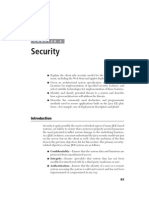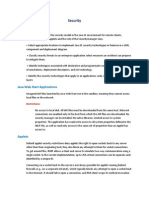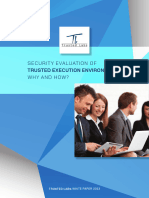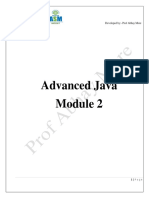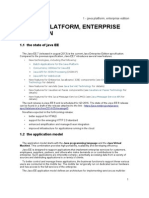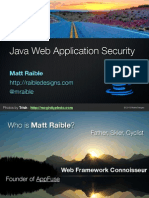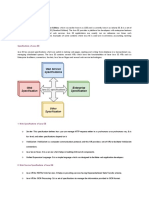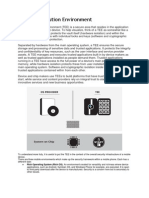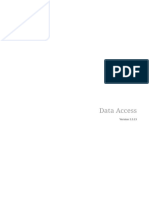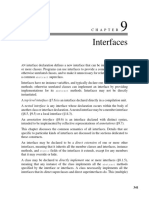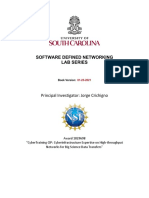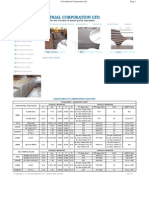Platform-Spec-8 - Chapter 3. Security
Uploaded by
Ciprian Nicu RosuPlatform-Spec-8 - Chapter 3. Security
Uploaded by
Ciprian Nicu RosuChapter 3.
Security
This chapter describes the security requirements for the Jakarta™ Enterprise Edition (Jakarta EE) that
must be satisfied by Jakarta EE products.
In addition to the Jakarta EE requirements, each Jakarta EE Product Provider will determine the level
of security and security assurances that will be provided by their implementation.
3.1. Introduction
Almost every enterprise has security requirements and specific mechanisms and infrastructure to
meet them. Sensitive resources that can be accessed by many users or that often traverse unprotected
open networks (such as the Internet) need to be protected.
Although the quality assurances and implementation details may vary, they all share some of the
following characteristics:
• Authentication : The means by which communicating entities (for example, client and server) prove
to one another that they are acting on behalf of specific identities that are authorized for access.
• Access control for resources : The means by which interactions with resources are limited to
collections of users or programs for the purpose of enforcing integrity, confidentiality, or
availability constraints.
• Data integrity : The means used to prove that information has not been modified by a third party
(some entity other than the source of the information). For example, a recipient of data sent over
an open network must be able to detect and discard messages that were modified after they were
sent.
• Confidentiality or Data Privacy : The means used to ensure that information is made available only
to users who are authorized to access it.
• Non-repudiation : The means used to prove that a user performed some action such that the user
cannot reasonably deny having done so.
• Auditing : The means used to capture a tamper-resistant record of security related events for the
purpose of being able to evaluate the effectiveness of security policies and mechanisms.
This chapter specifies how Jakarta EE platform requirements address security requirements, and
identifies requirements that may be addressed by Jakarta EE Product Providers. Finally, issues being
considered for future versions of this specification are briefly mentioned in Future Directions.
3.2. A Simple Example
The security behavior of a Jakarta EE environment may be better understood by examining what
happens in a simple application with a web client, a JSP user interface, and enterprise bean business
logic. (The example is not meant to specify requirements.)
Final Release Jakarta EE Platform 27
In this example, the web client relies on the web server to act as its authentication proxy by collecting
user authentication data from the client and using it to establish an authenticated session.
Initial Request
The web client requests the main application URL, shown in Initial Request .
Figure 3. Initial Request
Since the client has not yet authenticated itself to the application environment, the server responsible
for delivering the web portion of the application (hereafter referred to as “web server”) detects this
and invokes the appropriate authentication mechanism for this resource.
Initial Authentication
The web server returns a form that the web client uses to collect authentication data (for example,
username and password) from the user. The web client forwards the authentication data to the web
server, where it is validated by the web server, as shown in Initial Authentication .
Figure 4. Initial Authentication
The validation mechanism may be local to the server, or it may leverage the underlying security
services. On the basis of the validation, the web server sets a credential for the user.
URL Authorization
The credential is used for future determinations of whether the user is authorized to access
restricted resources it may request. The web server consults the security policy (derived from the
deployment descriptor) associated with the web resource to determine the security roles that are
permitted access to the resource. The web container then tests the user’s credential against each
role to determine if it can map the user to the role. URL Authorization shows this process.
Figure 5. URL Authorization
The web server’s evaluation stops with an “is authorized” outcome when the web server is able to map
the user to a role. A “not authorized” outcome is reached if the web server is unable to map the user to
28 Jakarta EE Platform Final Release
any of the permitted roles.
Fulfilling the Original Request
If the user is authorized, the web server returns the result of the original URLrequest, as shown in
Fulfilling the Original Request .
Figure 6. Fulfilling the Original Request
In our example, the response URL of a JSP page is returned, enabling the user to post form data that
needs to be handled by the business logic component of the application.
Invoking Enterprise Bean Business Methods
The JSP page performs the remote method call to the enterprise bean, using the user’s credential to
establish a secure association between the JSP page and the enterprise bean (as shown in Invoking
an Enterprise Bean Business Method ). The association is implemented as two related security
contexts, one in the web server and one in the Jakarta Enterprise Beans container.
Figure 7. Invoking an Enterprise Bean Business Method
The Jakarta Enterprise Beans container is responsible for enforcing access control on the enterprise
bean method. It consults the security policy (derived from the deployment descriptor) associated with
the enterprise bean to determine the security roles that are permitted access to the method. For each
role, the Jakarta Enterprise Beans container uses the security context associated with the call to
determine if it can map the caller to the role.
The container’s evaluation stops with an “is authorized” outcome when the container is able to map
the caller’s credential to a role. A “not authorized” outcome is reached if the container is unable to map
the caller to any of the permitted roles. A “not authorized” result causes an exception to be thrown by
Final Release Jakarta EE Platform 29
the container, and propagated back to the calling JSP page.
If the call “is authorized”, the container dispatches control to the enterprise bean method. The result of
the bean’s execution of the call is returned to the JSP, and ultimately to the user by the web server and
the web client.
3.3. Security Architecture
This section describes the Jakarta EE security architecture on which the security requirements defined
by this specification are based.
3.3.1. Goals
The following are goals for the Jakarta EE security architecture:
1. Portability: The Jakarta EE security architecture must support the Write Once, Run Anywhere™
application property.
2. Transparency: Application Component Providers should not have to know anything about security
to write an application.
3. Isolation: The Jakarta EE platform should be able to perform authentication and access control
according to instructions established by the Deployer using deployment attributes, and managed by
the System Administrator.
Note that divorcing the application from responsibility for security ensures greater portability of
Jakarta EE applications.
1. Extensibility: The use of platform services by security-aware applications must not compromise
application portability.
This specification provides APIs in the component programming model for interacting with
container/server security information. Applications that restrict their interactions to the provided APIs
will retain portability.
1. Flexibility: The security mechanisms and declarations used by applications under this specification
should not impose a particular security policy, but facilitate the implementation of security policies
specific to the particular Jakarta EE installation or application.
2. Abstraction: An application component’s security requirements will be logically specified using
Java language annotations or deployment descriptors. Java language annotations or deployment
descriptors will specify how security roles and access requirements are to be mapped into
environment-specific security roles, users, and policies. A Deployer may choose to modify the
security properties in ways consistent with the deployment environment. The annotations or
deployment descriptor should document which security properties can be modified and which
cannot.
3. Independence: Required security behaviors and deployment contracts should be implementable
30 Jakarta EE Platform Final Release
using a variety of popular security technologies.
4. Compatibility testing: The Jakarta EE security requirements architecture must be expressed in a
manner that allows for an unambiguous determination of whether or not an implementation is
compatible.
5. Secure interoperability: Application components executing in a Jakarta EE product must be able to
invoke services provided in a Jakarta EE product from a different vendor, whether with the same
or a different security policy. The services may be provided by web components or enterprise
beans.
3.3.2. Non Goals
The following are not goals for the Jakarta EE security architecture:
1. This specification does not dictate a specific security policy. Security policies for applications and
for enterprise information systems vary for many reasons unconnected with this specification.
Product Providers can provide the technology needed to implement and administer desired
security policies while adhering to the requirements of this specification.
2. This specification does not mandate a specific security technology, such as Kerberos, PK, NIS+, or
NTLM.
3. This specification does not require that the Jakarta EE security behaviors be universally
implementable using any or all security technologies.
4. This specification does not provide any warranty or assurance of the effective security of a Jakarta
EE product.
3.3.3. Terminology
This section introduces the terminology that is used to describe the security requirements of the
Jakarta EE platform.
Principal
A principal is an entity that can be authenticated by an authentication protocol in a security service
that is deployed in an enterprise. A principal is identified using a principal name and authenticated
using authentication data. The content and format of the principal name and the authentication
data can vary depending upon the authentication protocol.
Security Policy Domain
A security policy domain, also referred to as a security domain, is a scope over which a common
security policy is defined and enforced by the security administrator of the security service.
A security policy domain is also sometimes referred to as a realm. This specification uses the security
policy domain, or security domain, terminology.
Security Technology Domain
Final Release Jakarta EE Platform 31
A security technology domain is the scope over which the same security mechanism (for example
Kerberos) is used to enforce a security policy.
A single security technology domain may include multiple security policy domains, for example.
Security Attributes
A set of security attributes is associated with every principal. The security attributes have many
uses (for example, access to protected resources and auditing of users). Security attributes can be
associated with a principal by an authentication protocol and/or by the Jakarta EE Product Provider.
The Jakarta EE platform does not specify what security attributes are associated with a principal.
Credential
A credential contains or references information (security attributes) used to authenticate a
principal for Jakarta EE product services. A principal acquires a credential upon authentication, or
from another principal that allows its credential to be used (delegation).
This specification does not specify the contents or the format of a credential. The contents and format
of a credential can vary widely.
3.3.4. Container Based Security
Security for components is provided by their containers in order to achieve the goals for security
specified above in a Jakarta EE environment. A container provides two kinds of security (discussed in
the following sections):
• Declarative security
• Programmatic security
3.3.4.1. Declarative Security
Declarative security refers to the means of expressing an application’s security structure, including
security roles, access control, and authentication requirements in non-programmatic form. Java
language annotations and the deployment descriptor are the primary vehicles for declarative security
in the Jakarta EE platform.
Java language annotations and the deployment descriptor are a contract between an Application
Component Provider and a Deployer or Application Assembler. They can be used by an application
programmer to represent an application’s security related environmental requirements. A deployment
descriptor can be associated with groups of components.
A Deployer maps the declarative representation of the application’s security policy to a security
structure specific to the particular environment. A Deployer uses a deployment tool to process the
annotations and deployment descriptor.
At runtime, the container uses the security policy security structure derived from the declarative
32 Jakarta EE Platform Final Release
security information expressed in annotations and the deployment descriptor and configured by the
Deployer to enforce authorization (see Authorization Model).
3.3.4.2. Programmatic Security
Programmatic security refers to security decisions made by security aware applications. Programmatic
security is useful when declarative security alone is not sufficient to express the security model of the
application. The API for programmatic security consists of methods of the Jakarta Security
SecurityContext interface, and methods of the Jakarta Enterprise Beans EJBContext interface and the
servlet HttpServletRequest interface. The methods of the Jakarta Security SecurityContext interface are
intended to supersede the corresponding methods of the EJBContext and HttpServletRequest interfaces.
These methods allow components to make business logic decisions based on the security role of the
caller or remote user. For example they allow the component to determine the principal name of the
caller or remote user to use as a database key. (Note that the form and content of principal names will
vary widely between products and enterprises, and portable components will not depend on the actual
contents of a principal name. Due to principal name mapping, the same logical principal may have
different names in different containers, although usually it will be possible to configure a single
product to use consistent principal names. In particular, if a principal name is used as a key into a
database table, and that database table is accessed from multiple components, containers, or products,
the same logical principal may map to different entries in the database.)
3.3.5. Distributed Security
Some Product Providers may produce Jakarta EE products in which the containers for various
component types are distributed. In a distributed environment, communication between Jakarta EE
components can be subject to security attacks (for example, data modification and replay attacks).
Such threats can be countered by using a secure association to secure communications. A secure
association is shared security state information that establishes the basis of a secure communication
between components. Establishing a secure association could involve several steps, such as:
1. Authenticating the target principal to the client and/or authenticating the client to the target
principal.
2. Negotiating a quality of protection, such as confidentiality or integrity.
3. Setting up a security context for the association between the components.
Since a container provides security in Jakarta EE, secure associations for a component are typically
established by a container. Secure associations for web access are specified here. Secure associations
for access to enterprise beans are described in the Jakarta Enterprise Beans specification.
Product Providers may allow for control over the quality of protection or other aspects of secure
association at deployment time. Applications can specify their requirements for access to web
resources using annotations or elements in their deployment descriptor.
This specification does not define mechanisms that an Application Component Provider can use to
Final Release Jakarta EE Platform 33
communicate requirements for secure associations with an enterprise bean.
3.3.6. Authorization Model
The Jakarta EE authorization model is based on the concept of security roles. A security role is a logical
grouping of users that is defined by an Application Component Provider or Assembler. A Deployer
maps roles to security identities (for example principals, and groups) in the operational environment.
Security roles are used with both declarative security and programmatic security.
Declarative authorization can be used to control access to an enterprise bean method and is specified
in annotations or in the enterprise bean deployment descriptor. The RolesAllows , PermitAll , and
DenyAll annotations are used to specify method permissions. An enterprise bean method can also be
associated with a method-permission element in the deployment descriptor. The method-permission
element contains a list of methods that can be accessed by a given security role. If the calling principal
is in one of the security roles allowed access to a method, the principal is allowed to execute the
method. Conversely, if the calling principal is in none of the roles, the caller is not allowed to execute
the method. Access to web resources can be protected in a similar manner.
Security roles are used in the SecurityContext method isCallerInRole , the EJBContext method
isCallerInRole , and the HttpServletRequest method isUserInRole . Each method returns true if the
calling principal is in the specified security role.
3.3.6.1. Role Mapping
Enforcement of security constraints on web resources or enterprise beans, whether programmatic or
declarative, depends upon determination of whether the principal associated with an incoming
request is in a given security role. A container makes this determination based on the security
attributes of the calling principal. For example,
1. A Deployer may have mapped a security role to a user group in the operational environment or
may depend on the default mapping of security roles to user groups as defined by the Jakarta
Security specification. In this case, the user group of the calling principal is retrieved from its
security attributes. The principal is in the security role if the principal’s user group matches a user
group to which the security role has been mapped.
2. A Deployer may have mapped a security role to a principal name in a security policy domain. In
this case, the principal name of the calling principal is retrieved from its security attributes. If this
principal name is the same as a principal name to which the security role was mapped, the calling
principal is in the security role.
The source of security attributes may vary across implementations of the Jakarta EE platform. Security
attributes may be transmitted in the calling principal’s credential or in the security context. In other
cases, security attributes may be retrieved from an identity store, or from a trusted third party, such as
a directory service or a security service.
34 Jakarta EE Platform Final Release
3.3.7. HTTP Login Gateways
Secure interoperability between enterprise beans in different security policy domains is addressed in
the Jakarta Enterprise Beans specification. In addition, a component may choose to log in to a foreign
server via HTTP. An application component can be configured to use SSL mutual authentication for
security when accessing a remote resource using HTTP. Applications using HTTP in this way may
choose to use XML or some other structured format, rather than HTML.
We call the use of HTTP with SSL mutual authentication to access a remote service an HTTP Login
Gateway. Requirements in this area are specified in Authentication by Web Clients.
3.3.8. User Authentication
User authentication is the process by which a user proves his or her identity to the system. This
authenticated identity is then used to perform authorization decisions for accessing Jakarta EE
application components. An end user can authenticate using either of the two supported client types:
• Web client
• Application client
3.3.8.1. Authentication by Web Clients
It is required that a web client be able to authenticate a user to a web server using any of the following
mechanisms. The Deployer or System Administrator determines which method to apply to an
application or to a group of applications.
• HTTP Basic Authentication
HTTP Basic Authentication is the authentication mechanism supported by the HTTP protocol. This
mechanism is based on a username and password. A web server requests a web client to authenticate
the user. As part of the request, the web server passes the realm in which the user is to be
authenticated. The web client obtains the username and the password from the user and transmits
them to the web server. The web server then authenticates the user in the specified realm (referred to
as HTTP Realm in this document).
HTTP Basic Authentication is not secure. Passwords are sent in simple base64 encoding. The target
server is not authenticated. Additional protection can be applied to overcome these weaknesses. The
password may be protected by applying security at the transport layer (for example HTTPS) or at the
network layer (for example, IPSEC or VPN).
Despite its limitations, the HTTP Basic Authentication mechanism is included in this specification
because it is widely used in form based applications.
• HTTPS Client Authentication
End user authentication using HTTPS (HTTP over SSL) is a strong authentication mechanism. This
mechanism requires the user to possess a Public Key Certificate (PKC). Currently, a PKC is rarely used
Final Release Jakarta EE Platform 35
by end users on the Internet. However, it is useful for e-commerce applications and also for a single-
signon from within the browser. For these reasons, HTTPS client authentication is a required feature of
the Jakarta EE platform.
• Form Based Authentication
The look and feel of a login screen cannot be varied using the web browser’s built-in authentication
mechanisms. This specification introduces the ability to package standard HTML or servlet/JSP/JSF
based forms for logging in, allowing customization of the user interface. The form based
authentication mechanism introduced by this specification is described in the Servlet specification.
HTTP Digest Authentication is not widely supported by web browsers and hence is not required.
A web client can employ a web server as its authentication proxy. In this case, a client’s credential is
established in the server, where it may be used by the server for various purposes: to perform
authorization decisions, to act as the client in calls to enterprise beans, or to negotiate secure
associations with resources. Current web browsers commonly rely on proxy authentication.
3.3.8.2. Web Single Signon
HTTP is a stateless protocol. However, many web applications need support for sessions that can
maintain state across multiple requests from a client. Therefore, it is desirable to:
1. Make login mechanisms and policies a property of the environment the web application is
deployed in.
2. Be able to use the same login session to represent a user to all the applications that he or she
accesses.
3. Require re-authentication of users only when a security policy domain boundary has been crossed.
Credentials that are acquired through a web login process are associated with a session. The container
uses the credentials to establish a security context for the session. The container uses the security
context to determine authorization for access to web resources and for the establishment of secure
associations with other components (including enterprise beans).
3.3.8.3. Login Session
In the Jakarta EE platform, login session support is provided by a web container. When a user
successfully authenticates with a web server, the container establishes a login session context for the
[1]
user. The login session contains the credentials associated with the user.
3.3.8.4. Authentication by Application Clients
Application clients (described in detail in Application Clients) are client programs that may interact
with enterprise beans directly (that is, without the help of a web browser and without traversing a web
server). Application clients may also access web resources.
36 Jakarta EE Platform Final Release
Application clients, like the other Jakarta EE application component types, execute in a managed
environment that is provided by an appropriate container. Application clients are expected to have
access to a graphical display and input device, and are expected to communicate with a human user.
Application clients are used to authenticate end users to the Jakarta EE platform, when the users
access protected web resources or enterprise beans.
3.3.9. Lazy Authentication
There is a cost associated with authentication. For example, an authentication process may require
exchanging multiple messages across the network. Therefore, it is desirable to use lazy authentication,
that is, to perform authentication only when it is needed. With lazy authentication, a user is not
required to authenticate until there is a request to access a protected resource.
Lazy authentication can be used with first-tier clients (applets, application clients) when they request
access to protected resources that require authentication. At that point the user can be asked to
provide appropriate authentication data. If a user is successfully authenticated, the user is allowed to
access the resource.
3.4. User Authentication Requirements
The Jakarta EE Product Provider must meet the following requirements concerning user
authentication.
3.4.1. Login Sessions
All Jakarta EE web servers must maintain a login session for each web user. It must be possible for a
login session to span more than one application, allowing a user to log in once and access multiple
applications. The required login session support is described in the Servlet specification. This
requirement of a session for each web user supports single signon.
Applications can remain independent of the details of implementing the security and maintenance of
login information. The Jakarta EE Product Provider has the flexibility to choose authentication
mechanisms independent of the applications secured by these mechanisms.
Lazy authentication must be supported by web servers for protected web resources. When
authentication is required, one of the three required login mechanisms listed in the next section may
be used.
3.4.2. Required Login Mechanisms
All Jakarta EE products are required to support three login mechanisms: HTTP basic authentication,
SSL mutual authentication, and form-based login. An application is not required to use any of these
mechanisms, but they are required to be available for any application’s use.
Final Release Jakarta EE Platform 37
3.4.2.1. HTTP Basic Authentication
All Jakarta EE products are required to support HTTP basic authentication (RFC2068). Platform
Providers are also required to support basic authentication over SSL.
3.4.2.2. SSL Mutual Authentication
TLS 1.2 and the means to perform mutual (client and server) certificate-based authentication are
required by this specification.
All Jakarta EE products must also support TLS 1.1 and TLS 1.0, to ensure interoperable secure
communications with clients; however, TLS 1.0 should be disabled if not needed for a given
deployment, and TLS 1.1 may be disabled if not needed.
Similarly, all Jakarta EE products must support the following cipher suites, to ensure interoperable
secure communications with clients:
• TLS_RSA_WITH_AES_128_CBC_SHA
• TLS_DHE_RSA_WITH_AES_128_CBC_SHA
• TLS_ECDH_RSA_WITH_AES_128_CBC_SHA
• TLS_ECDH_ECDSA_WITH_AES_128_CBC_SHA
• TLS_ECDHE_RSA_WITH_AES_128_CBC_SHA
• TLS_ECDHE_ECDSA_WITH_AES_128_CBC_SHA
However, it is recommended to use the strongest possible cipher suite that can be negotiated between
client and server, and the above cipher suites may be disabled in favor of stronger cipher suites, if not
needed for a given deployment.
Note that previous versions of this specification required support for SSL 3.0, and for the following
cipher suites:
• TLS_RSA_WITH_RC4_128_MD5
• SSL_RSA_WITH_RC4_128_MD5
• TLS_DHE_DSS_WITH_3DES_EDE_CBC_SHA
• SSL_DHE_DSS_WITH_3DES_EDE_CBC_SHA
• TLS_RSA_EXPORT_WITH_RC4_40_MD5
• SSL_RSA_EXPORT_WITH_RC4_40_MD5
• TLS_DHE_DSS_EXPORT_WITH_DES40_CBC_SHA
• SSL_DHE_DSS_EXPORT_WITH_DES40_CBC_SHA
SSL 3.0 was officially deprecated by RFC 7568 in 2015, and is unsupported or disabled by default in
many TLS implementations. None of the above cipher suites is currently considered secure, and may
38 Jakarta EE Platform Final Release
be unsupported or disabled by default. In extreme cases, it may be necessary to use SSL 3.0, or to
negotiate one of the above cipher suites, in order to interoperate with an older client or a previous
version of Jakarta EE. However, it is recommended to use TLS 1.0 or higher, and to negotiate a stronger
cipher suite, whenever possible. SSL 3.0, and the above listed cipher suites, should be disabled if not
needed for interoperability in a given deployment.
3.4.2.3. Form Based Login
The web application deployment descriptor contains an element that causes a Jakarta EE product to
associate an HTML form resource (perhaps dynamically generated) with the web application. If the
Deployer chooses this form of authentication (over HTTP basic, or SSL certificate based
authentication), this form must be used as the user interface for login to the application.
The form based login mechanism and web application deployment descriptors are described in the
Servlet specification.
3.4.3. Unauthenticated Users
Web containers are required to support access to web resources by clients that have not authenticated
themselves to the container. This is the common mode of access to web resources on the Internet.
A web container reports that no user has been authenticated by returning null from the
SecurityContext method getCallerPrincipal or the HttpServletRequest method getUserPrincipal . This is
different than the result of the EJBContext method getCallerPrincipal . The Jakarta Enterprise Beans
specification requires that the EJBContext method getCallerPrincipal always return a valid Principal
object. This method can never return null . The SecurityContext method getCallerPrincipal can also be
called in the Jakarta Enterprise Beans container, and still returns null for anonymous users.
In Jakarta EE products that contain both a web container and an Jakarta Enterprise Beans container,
components running in a web container must be able to call enterprise beans even when no user has
been authenticated in the web container. When a call is made in such a case from a component in a
web container to an enterprise bean, a Jakarta EE product must provide a principal for use in the call.
A Jakarta EE product may provide a principal for use by unauthenticated callers using many
approaches, including, but not limited to:
• Always use a single distinguished principal.
• Use a different distinguished principal per server, or per session, or per application.
• Allow the deployer or system administrator to choose which principal to use through the Run As
capability of the web and enterprise bean containers.
This specification does not specify how a Jakarta EE product should choose a principal to represent
unauthenticated users, although future versions of this specification may add requirements in this
area. Note that the Jakarta Enterprise Beans specification does include requirements in this area when
using the Jakarta Enterprise Beans interoperability protocol. Applications are encouraged to use the
Run As capability in cases where the web component may be unauthenticated and needs to call Jakarta
Final Release Jakarta EE Platform 39
Enterprise Beans components.
3.4.4. Application Client User Authentication
The application client container must provide authentication of application users to satisfy the
authentication and authorization constraints enforced by the enterprise bean containers and web
containers. The techniques used may vary with the implementation of the application client container,
and are beyond the control of the application. The application client container may integrate with a
Jakarta EE product’s authentication system, to provide a single signon capability, or the container may
authenticate the user when the application is started. The container may delay authentication until
there is a request to access a protected resource or enterprise bean.
The container will provide an appropriate user interface for interactions with the user to gather
authentication data. In addition, an application client may provide a class that implements the
javax.security.auth.callback.CallbackHandler interface and specify the class name in its deployment
descriptor (see Jakarta EE Application Client XML Schema for details). The Deployer may override the
callback handler specified by the application and require use of the container’s default authentication
user interface instead.
If use of a callback handler has been configured by the Deployer, the application client container must
instantiate an object of this class and use it for all authentication interactions with the user. The
application’s callback handler must support all the Callback objects specified in the
javax.security.auth.callback package.
Application clients may execute in an environment controlled by a Java SE security manager and are
subject to the security permissions defined in Java Platform, Standard Edition (Java SE) Requirements.
Although this specification does not define the relationship between the operating system identity
associated with a running application client and the authenticated user identity, support for single
signon requires that the Jakarta EE product be able to relate these identities. Additional application
client requirements are described in CHApter of this specification.
3.4.5. Resource Authentication Requirements
Resources within an enterprise are often deployed in security policy domains different from the
security policy domain of the application component. The wide variance of authentication
mechanisms used to authenticate the caller to resources leads to the requirement that a Jakarta EE
product provide the means to authenticate in the security policy domain of the resource.
A Product Provider must support both of the following:
1. Configured Identity. A Jakarta EE container must be able to authenticate for access to the resource
using a principal and authentication data specified by a Deployer at deployment time.The
authentication must not depend in any way on data provided by the application components.
Providing for the confidential storage of the authentication information is the responsibility of the
Product Provider.
2. Programmatic Authentication. The Jakarta EE product must provide for specification of the
40 Jakarta EE Platform Final Release
principal and authentication data for a resource by the application component at runtime using
appropriate APIs. The application may obtain the principal and authentication data through a
variety of mechanisms, including receiving them as parameters, obtaining them from the
component’s environment, and so forth.
In addition, the following techniques are recommended but not required by this specification:
1. Principal Mapping. A resource can have a principal and attributes that are determined by a
mapping from the identity and security attributes of the requesting principal. In this case, a
resource principal is not based on inheritance of the identity or security attributes from a
requesting principal, but gets its identity and security attributes based on the mapping.
2. Caller Impersonation. A resource principal acts on behalf of a requesting principal. Acting on
behalf of a caller principal requires delegation of the caller’s identity and credentials to the
underlying resource manager. In some scenarios, a requesting principal can be a delegate of an
initiating principal and the resource principal is transitively impersonating an initiating principal.
The support for principal delegation is typically specific to a security mechanism. For example,
Kerberos supports a mechanism for the delegation of authentication. (Refer to the Kerberos v5
specification for more details.)
1. Credentials Mapping. This technique may be used when an application server and an EIS support
different authentication domains. For example:
2. The initiating principal may have been authenticated and have public key certificate-based
credentials.
3. The security environment for the resource manager may be configured with the Kerberos
authentication service.
The application server is configured to map the public key certificate-based credentials associated with
the initiating principal to the Kerberos credentials.
Additional information on resource authentication requirements can be found in the Connector
specification.
3.5. Authorization Requirements
To support the authorization models described in this chapter, the following requirements are
imposed on Jakarta EE products.
3.5.1. Code Authorization
A Jakarta EE product may restrict the use of certain Java SE classes and methods to secure and ensure
proper operation of the system. The minimum set of permissions that a Jakarta EE product is required
to grant to a Jakarta EE application is defined in Java Platform, Standard Edition (Java SE)
Requirements. All Jakarta EE products must be capable of deploying application components with
exactly these permissions.
Final Release Jakarta EE Platform 41
A Jakarta EE Product Provider may choose to enable selective access to resources using the Java
protection model. The mechanism used is Jakarta EE product dependent.
The permissions.xml descriptor (see Declaring Permissions Required by Application Components)
makes it possible to express permissions that a component needs for access.
3.5.2. Caller Authorization
A Jakarta EE product must enforce the access control rules specified at deployment time (see
Deployment Requirements) and more fully described in the Jakarta Enterprise Beans and Servlet
specifications.
3.5.3. Propagated Caller Identities.
In a Jakarta EE product that contains an Jakarta Enterprise Beans container, it must be possible to
configure the Jakarta EE product so that a propagated caller identity is used in all authorization
decisions. With this configuration, for all calls to all enterprise beans from a single application within a
single Jakarta EE product, the principal name returned by the EJBContext method getCallerPrincipal or
the SecurityContext method getCallerPrincipal must be the same as that returned by the first enterprise
bean in the call chain. If the first enterprise bean in the call chain is called by a servlet or JSP page, the
principal name must be the same as that returned by the HttpServletRequest method getUserPrincipal
or the SecurityContext method getCallerPrincipal in the calling servlet or JSP page. (However, if the
HttpServletRequest or SecurityContext method getCallerPrincipal returns null , the principal used in
calls to enterprise beans is not specified by this specification, although it must still be possible to
configure enterprise beans to be callable by such components.)
Note that this does not require delegation of credentials, only identification of the caller. A single
principal must be the principal used in authorization decisions for access to all enterprise beans in the
call chain. The requirements in this section apply only when a Jakarta EE product has been configured
to propagate caller identity.
3.5.4. Run As Identities
Jakarta EE products must also support the Run As capability that allows the Application Component
Provider and the Deployer to specify an identity under which an enterprise bean or web component
must run. In this case it is the Run As identity that is propagated to subsequent Jakarta Enterprise
Beans components, rather than the original caller identity.
Note that this specification doesn’t specify any relationship between the Run As identity and any
underlying operating system identity that may be used to access system resources such as files.
However, the Jakarta Authorization specification does specify the relationship between the Run As
identity and the access control context used by the Java SE security manager.
42 Jakarta EE Platform Final Release
3.6. Deployment Requirements
All Jakarta EE products must implement the access control semantics described in all included
component specifications, such as the Jakarta Enterprise Beans, Jakarta Server Pages, and Jakarta
Servlet specifications; provide a means of mapping the security roles specified in metadata
annotations or the deployment descriptor to the actual roles exposed by a Jakarta EE product; and
support the default mapping from user groups to roles defined by the Jakarta Security specification.
While most Jakarta EE products will allow the Deployer to customize the role mappings and change the
assignment of roles to methods, all Jakarta EE products must support the ability to deploy applications
and components using exactly the mappings and assignments specified in their metadata annotations
or deployment descriptors.
As described in the Jakarta Enterprise Beans specification and the Servlet specification, a Jakarta EE
product must provide a deployment tool or tools capable of assigning the security roles in metadata
annotations or deployment descriptors to the entities that are used to determine role membership at
authorization time.
Application developers will need to specify (in the application’s metadata annotations or deployment
descriptors) the security requirements of an application in which some components may be accessed
by unauthenticated users as well as authenticated users (as described above in Unauthenticated
Users). Applications express their security requirements in terms of security roles, which the Deployer
maps to users (principals) in the operational environment at deployment time. An application might
define a role representing all authenticated and unauthenticated users and configure some enterprise
bean methods to be accessible by this role.
To support such usage, this specification requires that it be possible to map an application defined
security role to the universal set of application principals independent of authentication. __
3.7. Future Directions
3.7.1. Auditing
This specification does not specify requirements for the auditing of security relevant events, nor APIs
for application components to generate audit records. A future version of this specification may
include such a specification for products that choose to provide auditing.
3.7.2. Instance-based Access Control
Some applications need to control access to their data based on the content of the data, rather than
simply the type of the data. We refer to this as “instance-based” rather than “class-based” access
control. We hope to address this in a future release.
Final Release Jakarta EE Platform 43
3.7.3. User Registration
Web-based internet applications often need to manage a set of customers dynamically, allowing users
to register themselves as new customers. This scenario was widely discussed in the Servlet expert
group (JSR-53) but we were unable to achieve consensus on the appropriate solution. We had to
abandon this work for J2EE 1.3, and were not able to address it for J2EE 1.4, but hope to pursue it
further in a future release.
[1] While the client is stateless with respect to authentication, the client requires that the server act as
its proxy and maintain its login context. A reference to the login session state is made available to the
client through cookies or URL re-writing. If SSL mutual authentication is used as the authentication
protocol, the client can manage its own authentication context, and need not depend on references to
the login session state.
44 Jakarta EE Platform Final Release
You might also like
- Security: Confidentiality Integrity AuthenticationNo ratings yetSecurity: Confidentiality Integrity Authentication5 pages
- Date: Experiment No. 1 Aim: To Study J2EE.: TheoryNo ratings yetDate: Experiment No. 1 Aim: To Study J2EE.: Theory71 pages
- A Distributed Component Architecture Model: ViewpointsNo ratings yetA Distributed Component Architecture Model: Viewpoints11 pages
- Java ™ Cryptography Architecture (JCA) Reference Guide: For Java Platform Standard Edition 6No ratings yetJava ™ Cryptography Architecture (JCA) Reference Guide: For Java Platform Standard Edition 695 pages
- Lecture Topics: Let's Start With Buzzwords. J2EE ProvidesNo ratings yetLecture Topics: Let's Start With Buzzwords. J2EE Provides5 pages
- J2Ee/Jee (Java 2 Enterprise Edition) TechnologyNo ratings yetJ2Ee/Jee (Java 2 Enterprise Edition) Technology36 pages
- Putting It All Together Some EJB™ Design Issues and J2EE SecurityNo ratings yetPutting It All Together Some EJB™ Design Issues and J2EE Security31 pages
- Platform-Spec-8 - Appendix B Java EE 8 and JakaNo ratings yetPlatform-Spec-8 - Appendix B Java EE 8 and Jaka4 pages
- Spring-Framework - Optimize - Chapter 9. AppendixNo ratings yetSpring-Framework - Optimize - Chapter 9. Appendix2 pages
- Spring-Framework - Optimize - Chapter 8. Language SupportNo ratings yetSpring-Framework - Optimize - Chapter 8. Language Support36 pages
- Spring-Framework - Optimize - Chapter 5. Web On Servlet StacNo ratings yetSpring-Framework - Optimize - Chapter 5. Web On Servlet Stac250 pages
- Spring-Framework - Optimize - Chapter 2. Core TechnologiesNo ratings yetSpring-Framework - Optimize - Chapter 2. Core Technologies478 pages
- Java EE 7 Maven Archetypes in The TutorialNo ratings yetJava EE 7 Maven Archetypes in The Tutorial3 pages
- Lecture - 01b - Fundamentals in Wireless Transmissions StallingsNo ratings yetLecture - 01b - Fundamentals in Wireless Transmissions Stallings37 pages
- Bommer Et Al 2015 A Sshac Level 3 Probabilistic Seismic Hazard Analysis For A New Build Nuclear Site in South AfricaNo ratings yetBommer Et Al 2015 A Sshac Level 3 Probabilistic Seismic Hazard Analysis For A New Build Nuclear Site in South Africa38 pages
- Analysis of Training Evaluation Process Using Kirkpatrick'S Training Evaluation Model at Pt. Bank Tabungan Negara (Persero) TBKNo ratings yetAnalysis of Training Evaluation Process Using Kirkpatrick'S Training Evaluation Model at Pt. Bank Tabungan Negara (Persero) TBK10 pages
- Reflection On Sports and Exercise PsychologyNo ratings yetReflection On Sports and Exercise Psychology2 pages
- Result Declared - MJ - 2025 - 05.07.2025No ratings yetResult Declared - MJ - 2025 - 05.07.202547 pages
- Mfat Action Plan Implementation Sy 2021-2022No ratings yetMfat Action Plan Implementation Sy 2021-20221 page
- Instant Access To The Problem Centred Interview Principles and Practice Andreas Witzel Ebook Full Chapters100% (10)Instant Access To The Problem Centred Interview Principles and Practice Andreas Witzel Ebook Full Chapters77 pages
- Art Journal 45 3 Video The Reflexive Medium PDFNo ratings yetArt Journal 45 3 Video The Reflexive Medium PDF85 pages

